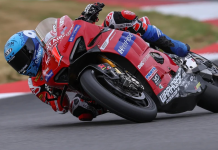Three-Year Motorcycle Industry Council Effort Leads to New Roadside Sound Test SAE Standard Benefits Riders Everywhere by Accurately Identifying Excessively Loud Exhausts Irvine, Calif., June 24, 2009 – On-highway riders and their bikes don’t have to be victims of questionable sound-level checks anymore, thanks to a new procedure developed by the Motorcycle Industry Council in partnership with SAE International, and adopted by the global association, known for establishing a wide range of motor vehicle standards. Now, law-enforcement authorities have a simple, quick, economical and science-based tool for accurately identifying motorcycles with excessively loud exhaust systems. The SAE document J2825, “Measurement of Exhaust Sound Pressure Levels of Stationary On-Highway Motorcycles,” meets the need for a practical, consistent roadside sound test. Three years ago, the MIC initiated and began executing the $250,000 project, conducting field-testing, analyzing the data, and providing the initial draft standard. A representative sample of 25 motorcycles and more than 50 aftermarket exhaust systems were tested. Collaborating with the MIC throughout, the SAE Motorcycle Technical Steering Committee validated the scope of work and co-wrote the final standard. “The winners are riders everywhere, who no longer need to be subjected to arbitrary local jurisdictions,” said MIC President Tim Buche. “The new SAE standard provides a much-needed alternative to outright bans, restrictions and sound test standards that vary state to state and city to city, frustrating riders, exhaust system manufacturers, and municipal governments alike,” he said. “With J2825, we can now have uniform standards and testing that’s easy to administer.” SAE J2825 is similar to J1287, the procedure widely used for off-highway motorcycles and all-terrain vehicles since the 1980s. The J2825 roadside test is conducted by holding a sound meter 20 inches behind the exhaust outlet, at the same height, and 45 degrees from the line of travel of the motorcycle. The procedure includes two tests: an Idle Test and a Set RPM Test. The Idle Test is the easiest to administer and can be used to screen various mufflers. But the Set RPM Test is the most effective in identifying excessively loud exhaust systems. A non-constant, Swept RPM Test Method also is included as an alternative to the Set RPM Test, for motorcycles that will not hold constant rpm. The SAE recommends that the following lowest numerical limits be adopted: * 92 dBA at idle for all motorcycles * 96 dBA for motorcycles with fewer than three cylinders or more than four cylinders at 2000 rpm (or 75 percent of maximum engine speed, whichever is less) * 100 dBA for motorcycles with three or four cylinders at 5,000 rpm (or 75 percent of maximum engine speed, whichever is less) And, 2 dBA should be added to these sound limits for motorcycle exhaust systems that are clearly labeled as meeting the EPA sound limits and have not been obviously modified or tampered with. “Over-regulation in reaction to excessively loud exhaust systems is one of greatest threats to motorcycling,” Buche said. “Thanks to the determined efforts of the MIC OE Technical Committee, the SAE Motorcycle Technical Steering Committee, the MIC American V-Twin Committee, MIC member aftermarket exhaust system companies, MIC consultant Tom Austin of Sierra Research, MIC Vice President Pamela Amette, MIC-member OE manufacturers and distributors, plus supplemental funding from non-members Harley-Davidson and the Motorcycle & Moped Industry Council of Canada, we finally have a stationary sound test procedure for on-highway motorcycles that works very well and should be adopted across the country.” The SAE J2825 standard can be downloaded on the SAE website for a list price of $61 at ~http://www.sae.org/technical/standards/J2825_200905~. The Motorcycle Industry Council exists to preserve, protect and promote motorcycling through government relations, communications and media relations, statistics and research, aftermarket programs, development of data communications standards, and activities surrounding technical and regulatory issues. It is a not-for-profit, national trade association representing manufacturers and distributors of motorcycles, scooters, motorcycle/ATV/ROV parts and accessories, and members of allied trades such as publishing companies, advertising agencies, insurance firms and consultants. The MIC is headquartered in Irvine, Calif., with a government relations office adjacent to Washington, D.C. First called the MIC in 1970, the organization has been in operation since 1914.
More On That New SAE Motorcycle Exhaust Sound Level Test Standard
More On That New SAE Motorcycle Exhaust Sound Level Test Standard
© 2009, Roadracing World Publishing, Inc.






